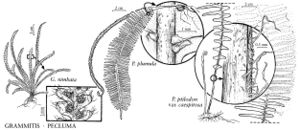Difference between revisions of "Pecluma plumula"
Amer. Fern J. 73: 115. 1983.
Common names: Plume polypody
Illustrated
Basionym: Polypodium plumula Humboldt & Bonpland ex Willdenow Sp. Pl. 5(1): 178. 1810
Treatment appears in FNA Volume 2.
imported>Volume Importer |
imported>Volume Importer |
||
| Line 56: | Line 56: | ||
|publication year=1983 | |publication year=1983 | ||
|special status=Illustrated | |special status=Illustrated | ||
| − | |source xml=https:// | + | |source xml=https://bitbucket.org/aafc-mbb/fna-data-curation/src/2e0870ddd59836b60bcf96646a41e87ea5a5943a/coarse_grained_fna_xml/V2/V2_153.xml |
|genus=Pecluma | |genus=Pecluma | ||
|species=Pecluma plumula | |species=Pecluma plumula | ||
Latest revision as of 20:21, 5 November 2020
Stems ca. 5 mm diam.; scales dark brown, linear-lanceolate. Leaves pendent, sometimes erect in small plants. Petiole black, 1/10–1/5 length of blade, hairs few, unbranched; scales ovate to cordate, conspicuous, inflated. Blade linear-elliptic, 15–50 × 3–7 cm; base abruptly cuneate; apex tapering to acute. Segments linear, 1.5–2.5 mm wide, sparsely short-pubescent; segments at base of blade abruptly reduced to lobes, not deflexed. Veins 1-forked. Sori round; sporangia with 64 spores. 2n = 148.
Phenology: Sporulating all year.
Habitat: Epiphytic or occasionally on rock, wet woods, river banks, hammocks, and limesinks
Elevation: 0 m
Distribution

Fla., Mexico, West Indies, Central America, South America to s Brazil.
Discussion
Selected References
None.
Lower Taxa
None.
